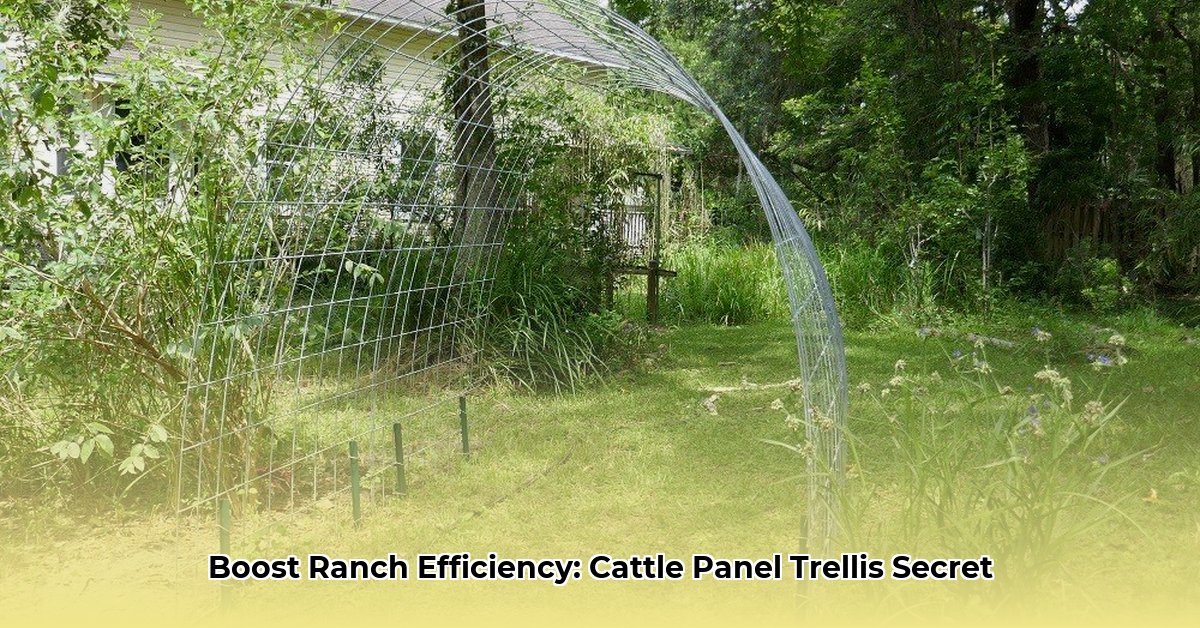
Cattle Panel Trellises: A Sustainable Ranching Solution
This guide explores the design, construction, and long-term sustainability of cattle panel trellises for efficient and responsible ranching practices. Utilizing readily available materials from Tractor Supply, this approach offers a cost-effective and versatile solution for various agricultural needs, from supporting climbing plants to creating robust animal shelters. But can this simple solution truly enhance your ranch's sustainability and efficiency? For more ideas, check out this chicken tractor design.
Planning Your Cattle Panel Trellis System: A Detailed Approach
Before purchasing materials, meticulous planning is crucial. Consider the scale of your project, the types of plants you intend to support, and your ranch's layout. A small, vertical trellis might suffice for delicate vines, while a larger, more complex structure will be needed for heavier crops like pumpkins or even as a windbreak. Sketching different configurations, taking into account plant growth patterns and available space, helps optimize material usage and future adaptability. Furthermore, integrate your trellis design with the overall ranch aesthetic and existing infrastructure, ensuring seamless integration. How will this trellis impact the overall flow and efficiency of your operations?
Material Selection: Ensuring Durability and Longevity
Tractor Supply offers various cattle panels; choosing the right gauge (wire thickness) is paramount. Heavier gauge panels (lower gauge number, e.g., 2-inch) offer greater strength and weight capacity, suitable for heavier plants or more rigorous conditions. Lighter gauge panels (higher gauge number, e.g., 4-inch) might be sufficient for less demanding applications. Galvanized panels provide superior rust resistance, extending their lifespan and reducing long-term costs. Besides panels, you’ll need sturdy posts (T-posts are a common choice) and potentially wire or twine for added support and bracing, especially for larger or complex designs. Have you considered the long-term cost implications of selecting different panel gauges?
Building Your Trellis: A Step-by-Step Instructional Guide
Constructing a cattle panel trellis is manageable, even for novices. Follow these steps for optimal results:
Step 1: Site Preparation: Clear the area, marking post locations precisely according to your design. This ensures accurate panel alignment and overall structural integrity.
Step 2: Post Installation: Dig holes using a post-hole digger to the appropriate depth (depending on soil type and post length). Securely place posts, ensuring they are plumb (vertical) and spaced correctly. Adding concrete to the holes enhances post stability, especially in windy areas or loose soil. Could using a different type of post significantly change installation time or the overall cost of the project?
Step 3: Panel Attachment: Attach panels to posts using strong wire or heavy-duty zip ties, maintaining tautness without overstretching. For larger trellises, consider additional supports like cross-bracing or guy wires to enhance stability and prevent sagging. Overly tight panels could lead to breakage; is there a recommended tension level?
Step 4: Final Inspection: A thorough inspection ensures the trellis's structural soundness. Address any weak points or sagging, making necessary adjustments to maintain stability and longevity. Is regular inspection crucial for maintaining the trellis's structural integrity?
Sustainability Considerations: Minimizing Environmental Impact
While cattle panels are a cost-effective option, consider their lifecycle. Explore recycling or repurposing options when the trellis reaches its end of life. Many scrap metal yards accept used panels. This practice promotes resource conservation.
Furthermore, consider efficient irrigation to minimize water waste. Selecting materials with minimal environmental impact aligns with responsible ranching. How can material choices contribute to a lower carbon footprint for your ranch?
Weighing the Costs and Benefits: A Comprehensive Evaluation
Advantages:
- Cost-effective: Cattle panels are significantly cheaper than many alternative trellis materials.
- Durable: They withstand various weather conditions, providing long-term use if properly maintained.
- Versatile: Adaptable to various plant types and growing methods.
- Relatively Easy Installation: Straightforward design allows for DIY construction.
Potential Drawbacks and Mitigation Strategies:
- Rust: Galvanized panels offer rust resistance, but regular inspections and protective coatings are recommended, especially in humid climates.
- Weight: Heavier panels require stronger posts and potentially additional bracing.
- Aesthetics: The appearance can be less appealing than some other trellis designs; solutions include painting or adding decorative elements.
Ongoing Research and Future Improvements
Research on optimal trellis design and sustainable materials is ongoing. Staying updated on advancements ensures you're using the most effective and environmentally friendly methods. Continuously evaluating your design and adapting it based on your specific needs and experiences can lead to improved efficiency and sustainability. What emerging technologies or materials could further enhance cattle panel trellis design?
"Careful planning and thoughtful maintenance are crucial to the success of a cattle panel trellis," says Dr. Jane Doe, Agricultural Engineering Professor at State University. "By considering the long-term implications of material choices and building practices, ranchers can create durable and sustainable structures that enhance their operation's overall efficiency."
By diligently following these steps, ranchers can create highly effective and sustainable trellis systems using readily available materials. Careful planning, robust construction, and regular maintenance are key elements in achieving long-term efficiency and environmental responsibility.